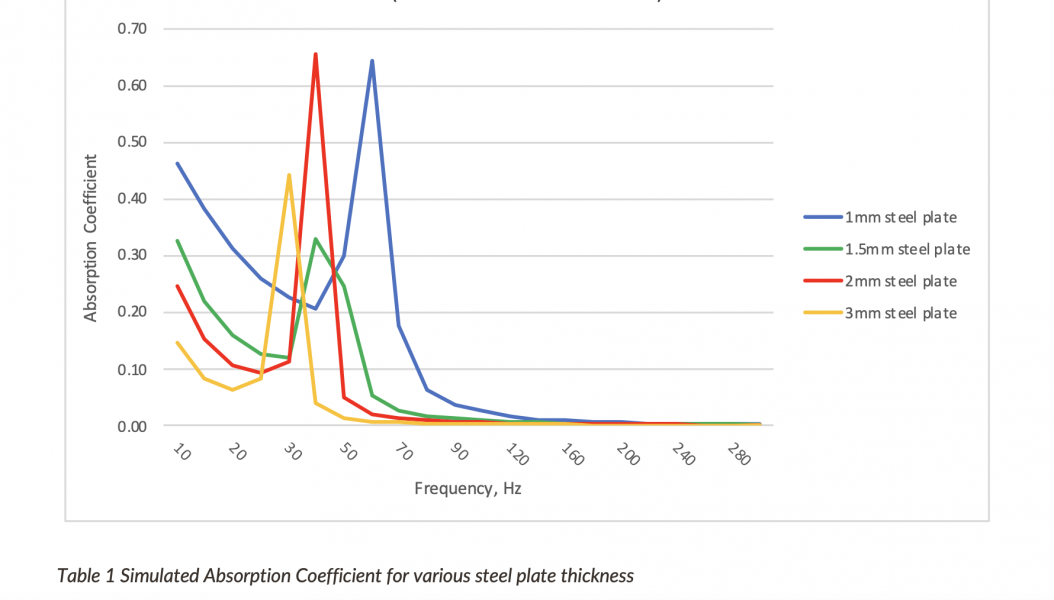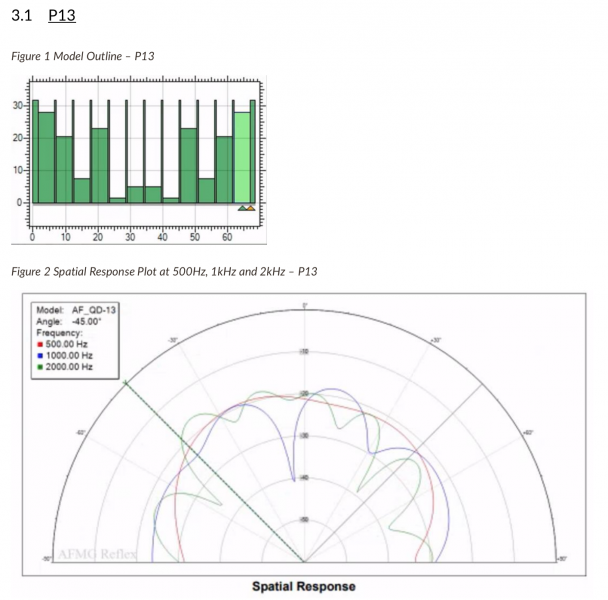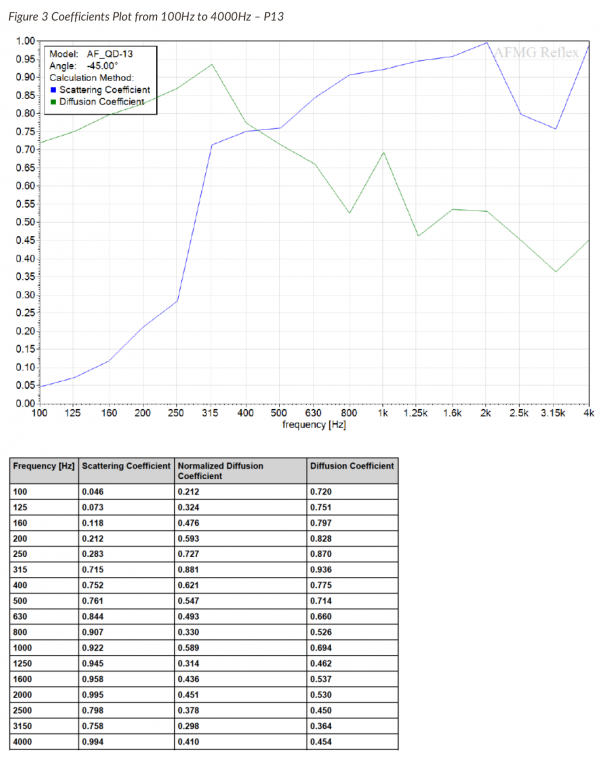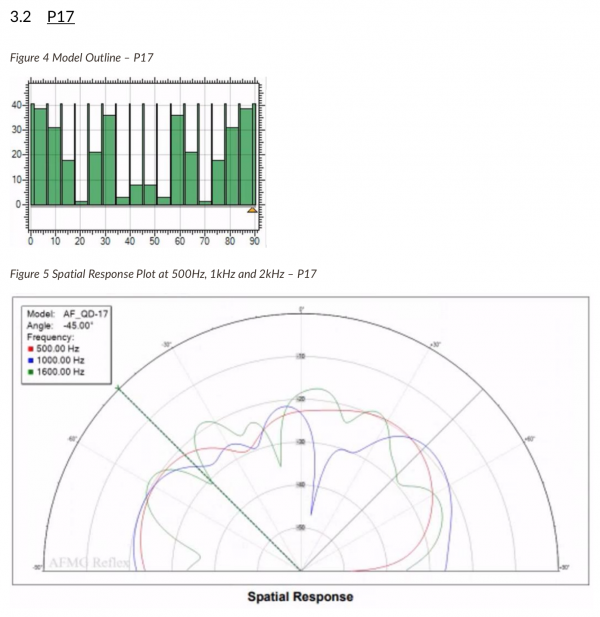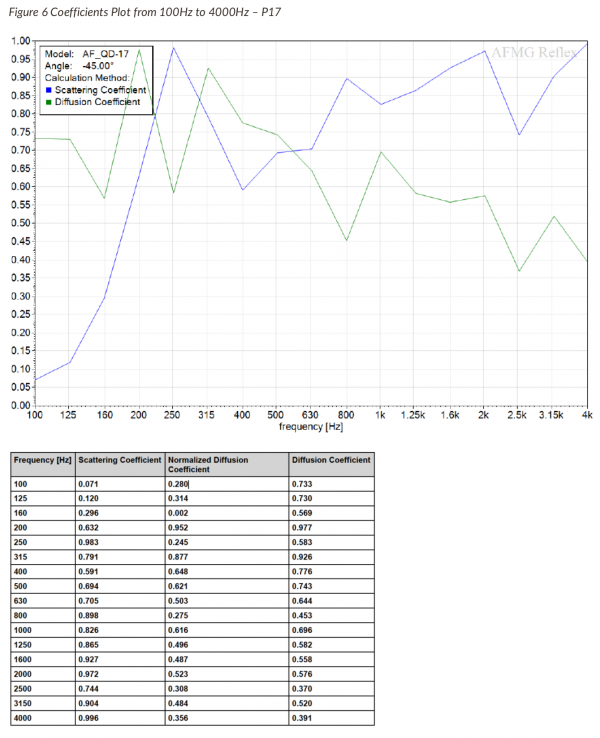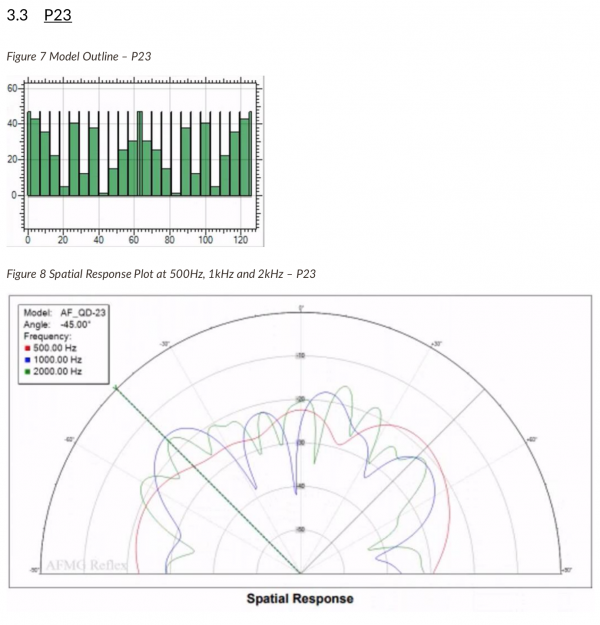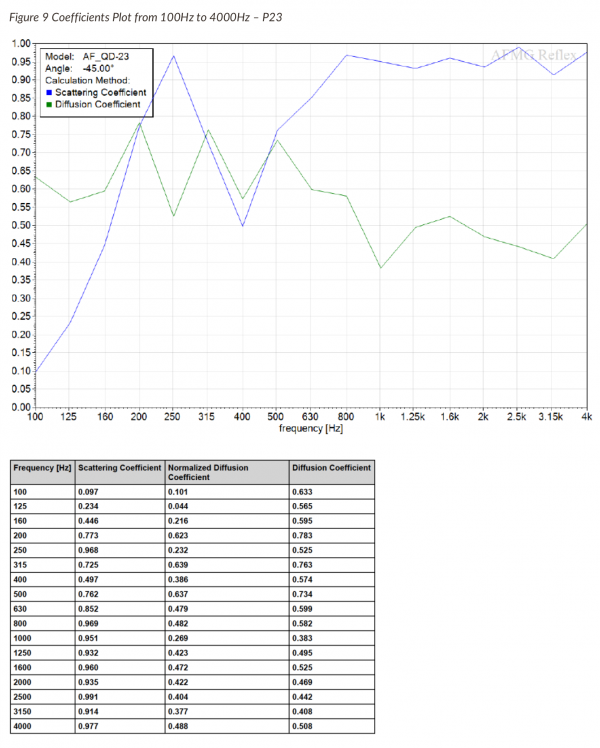What... no dipolesSPEAKER CHOICES
Perhaps it's not too early to start daydreaming about component choices for my future basement listening room scheduled for completion in 24 months' time.
I'm a huge fan of linear, predictable, and objectively measured (PROVEN) wide off-axis polar response, combining point-source approximation to create a deep/wide soundstage, dynamically scalable pin-point 3D imaging by WORKING with room acoustics (for the mid/highs) and floor/wall boundaries (for natural augmentation of sub-200Hz long bass wavelengths).
My preference is for vertically aligned dynamic drivers on an appropriately contoured and minimized baffle surface area, with tweeter(s) on top, ideally at ear-height or slightly higher to project a slightly elevated soundscape, and the midrange placed below at very close proximity to the tweeter, ideally within 1/2 the crossover frequency wavelength to minimize deleterious interactions.
I'm not a fan of M-T-M D'Appolito arrays, as I can easily hear driver nulls which among other undesirable polar inconsistencies, separate music into vertical layers of horizontalized donut "rings". I also don't care about "time alignment" through second-order crossovers or voice-coil alignment into a common horizontal plane and vertical line. Anyone who can read a step-response curve knows that propagated sound arrives at different times THROUGHOUT the frequency range, and that achieving perfect time alignment at the listening position is but a misguided dream, and more importantly, our listening ear/brain mechanism is not particularly sensitive to group delay.
Applying DSP correction to "time align" arrivals isn't my taste either, as that introduces off-axis anomalies which suck the life out of music, according to my experience experimenting with the one of the most sophisticated room correction equipment featuring a mic array with four microphone capsules (to capture vertical azimuth data).
As far as I know (and heard/seen), only offerings from Von Schweikert Audio provides the adjustability and flexibility to optimize its acoustic output to optimize various loudspeaker placement locations, and room size/volume - attributes which are unique in the marketplace... I'm a HUGE fan of VSA!
But I'm casting a wide net out of an abundance of curiosity, and earmarking flagship models from multiple manufacturers (listed below in alphabetical order) for auditioning in an optimized-room-acoustics listening room to properly showcase the capabilities of the loudspeaker. Given the excitement and media coverage at High End Munich 2023, some European brands which I have not auditioned extensively have been added below.
Have I missed any others, which broadly deliver on the performance characteristics I'm looking for?
* * * * *
Magico (upcoming M7/M8 incorporating trickle-down technologies from the M9)
Marten (audition pending)
Rockport (Lyra - audition pending)
Von Schweikert Audio (Ultra 7 or 9 + pair of high-level input bass-management subwoofers)
TAD (co-axial drivers, ie. Reference 1-TX)
Vimberg/TIDAL (auditions pending)
Vivid (upcoming flagship model, one slot above the Giya G1 Spirit)
Zellaton (audition pending)
My dedicated audio room build - QuadDiffusor's Big Dig
- Thread starter QuadDiffuser
- Start date
You are using an out of date browser. It may not display this or other websites correctly.
You should upgrade or use an alternative browser.
You should upgrade or use an alternative browser.
Hi SBNX, yes the Sonus Faber Aida does have rear-projection drivers, but there is zero information on the design goals, and technical details on how the crossovers/rear drivers complement the front firing drivers. I've auditioned them in various locations/set ups, mainly at AXPONA 2022 and AXPONA 2023, but regret that I have not been moved by their design nor sound.You have some very nice choices in your list. The speakers in your list have a wide range of tonality. Having a speaker that offers some adjustability is a huge thing in getting it to work in a room. The only speaker in your list that has adjustability it the VSA. Another speaker similar is the Sonus Faber Aida. It offers a good amount of adjustability and something to consider
Last edited:
Nope, sorry no line-arrays for me.You might also consider use Nearfield Acoustic Pipedream speakers.
Last edited:
Luckily, I'm going to be able to widen my dedicated basement listening room's width.
Here are the latest dimensions of the structural slabs/walls:
4.20m(H) or 13.8ft = 40.9Hz 1st order resonance frequency
7.00m(W) or 23.0ft = 24.6Hz 1st order resonance frequency
10.45m(L) or 34.3ft = 17.2Hz 1st order resonance frequency
Surface area (floor): 73.2 square meters, or 787.4 square feet
Volume: 307.2 cubic meters, or 10,850 cubic feet
Shroeder frequency: 88Hz
Critical distance: 1.29m
The dimensional ratios of 1.00 x 1.67 x 2.49 will outside of the (theoretically) optimal Bolt-Area graph, but I'm not worried, as there will be PLENTY of bass mode suppression, including a room-in-a-room construction using damped sheetrock, and dozens of Hemholtz resonance plates mounted directly on the four structural walls, including the ceiling.
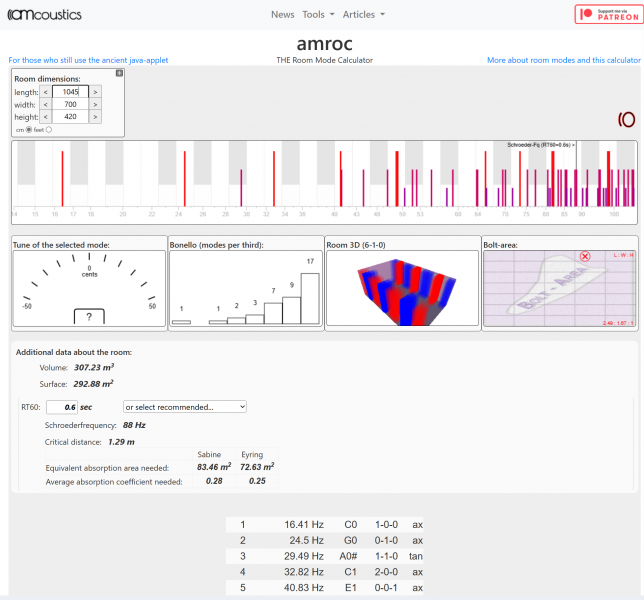
Here are the latest dimensions of the structural slabs/walls:
4.20m(H) or 13.8ft = 40.9Hz 1st order resonance frequency
7.00m(W) or 23.0ft = 24.6Hz 1st order resonance frequency
10.45m(L) or 34.3ft = 17.2Hz 1st order resonance frequency
Surface area (floor): 73.2 square meters, or 787.4 square feet
Volume: 307.2 cubic meters, or 10,850 cubic feet
Shroeder frequency: 88Hz
Critical distance: 1.29m
The dimensional ratios of 1.00 x 1.67 x 2.49 will outside of the (theoretically) optimal Bolt-Area graph, but I'm not worried, as there will be PLENTY of bass mode suppression, including a room-in-a-room construction using damped sheetrock, and dozens of Hemholtz resonance plates mounted directly on the four structural walls, including the ceiling.

Some preliminary plans for my newly-positioned basement listening room.
[note that my target RT60 will be ~0.5sec, not 0.8sec]
1) positioned into the eastern corner, directly under the main entrance to the house
2) three structural walls with tons of earth/soil behind them, ensuring zero environmental and EMI noise
3) slightly lower (and more manageable) floor-to-ceiling slab height of 4.2m, compared to the previous crazy height of 6.4m
4) width of 7.0m is identical, and length of 10.6m is slightly longer than the previous dimensions
5) axial room nodes calculated to be ~32Hz, ~43Hz, and ~49Hz (but needs to be recalculated, as they do not match those in post #44)
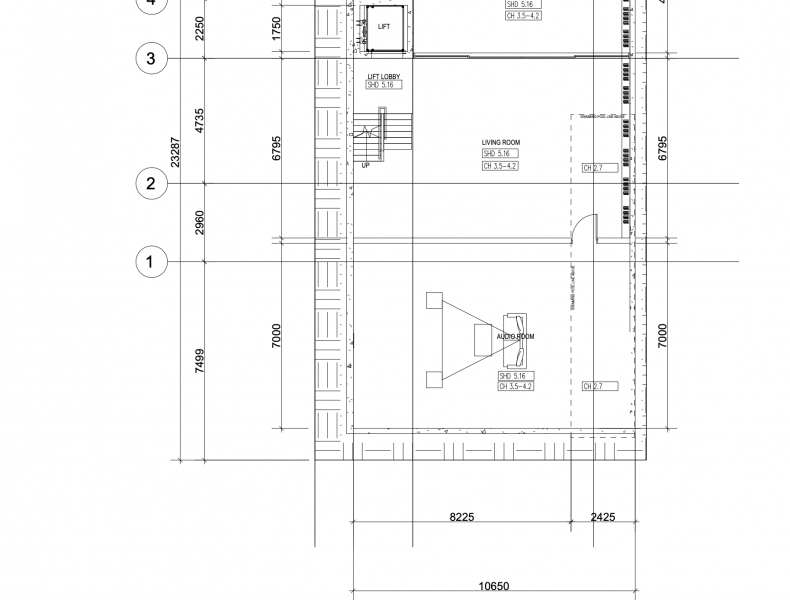
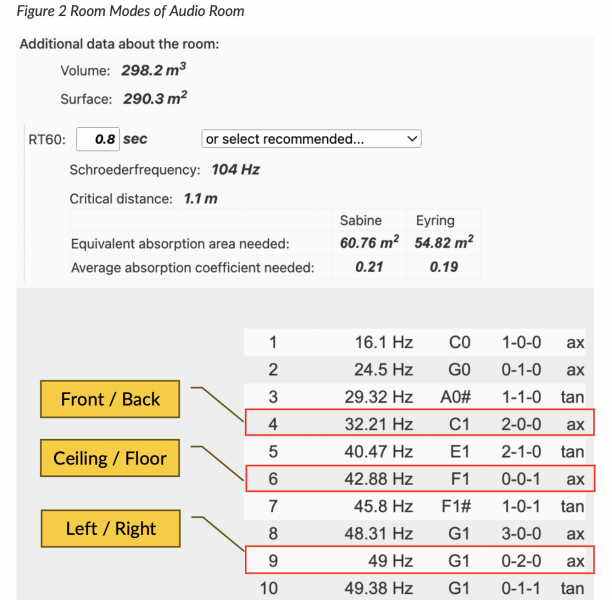
[note that my target RT60 will be ~0.5sec, not 0.8sec]
1) positioned into the eastern corner, directly under the main entrance to the house
2) three structural walls with tons of earth/soil behind them, ensuring zero environmental and EMI noise
3) slightly lower (and more manageable) floor-to-ceiling slab height of 4.2m, compared to the previous crazy height of 6.4m
4) width of 7.0m is identical, and length of 10.6m is slightly longer than the previous dimensions
5) axial room nodes calculated to be ~32Hz, ~43Hz, and ~49Hz (but needs to be recalculated, as they do not match those in post #44)


Last edited:
Last edited:
Current proposal, with outstanding questions.
Please chime in with your experiences and suggestions for those prefixed with a "Q" !
Four walls:
1) first layer: dampened gypsum boards (air gap filled with dense Rockwool)
2) second layer: metal-plate Helmholtz bass resonators (tuned to the ~32Hz and ~43Hz axial room nodes)
3) third layer: P23 quadratic diffusors with the deepest bass diffusion bandwidth, for the front wall
4) shallower P17 quadratic diffusers for the sidewalls, but believe it's best not to have any closer than 2.0m from the listening position, due to undesirable comb filtering artifacts (which become inaudible at greater distances)
Q1) should the metal-plate Helmholtz bass resonators be mounted directly onto the structural walls, instead on the sheetrock?
Q2) should the sheetrock be mounted over the Helmholtz bass absorbers, and the larger air gap filled with dense Rockwool?
Q3) can the room be over-damped with too many Helmholtz bass absorbers, and if so, what might be the optimal % fill factor?
Q4) position/quantity of the sidewall P17 quadratic diffusers - one pair, two pairs, three pairs, or keep all four pairs?
Q5) quadratic 1D diffusers, BAD half-cylinders, or absorption (via dense open-cell foam) at the first reflection zones?
Q6) with so many metal-plate Helmholtz resonators, are corner bass traps needed or can they be disregarded to save space?
Ceiling:
1) first layer: metal plate Helmholtz bass resonators (tuned to the ~49Hz axial room node)
2) second layer: canopy, either P13 quadratic diffusers in a 2D configuration, or /lighter shallower 2D quadratic diffusers
Q1) ~3.5m high false ceilings imply 7.0m roundtrip; as acoustic energy returning from the ceiling are relatively weak and potentially inaudible, are ceiling diffusers a must-have?
Q2) deep, heavy, large P13 1D quadratic diffusers arranged into 2D configuration (90* orientation, alternating)?
Q3) alternatively, "2D diffusers" with 10x10 or 12x12 small squares?
Floor:
1) base finish: self-leveling epoxy + paint finish
Q1) option 1: vinyl tile flooring (covering the base finish)
Q2) option 2: polyester/nylon carpet "squares" (covering the base finish)
Q3) plywood over concrete, then engineered wood parquet
Carpet/rug:
Q1) option 1: thin rug (Persian-style?) placed on the rectangle between the loudspeakers and listening position
Q2) option 2: decorative rug made of open-weave fabric/yarn, to discourage over-absorption
Q3) option 3: low-pile carpet (IKEA type, typically available in 2m x 3m size), to encourage absorption of mids/highs
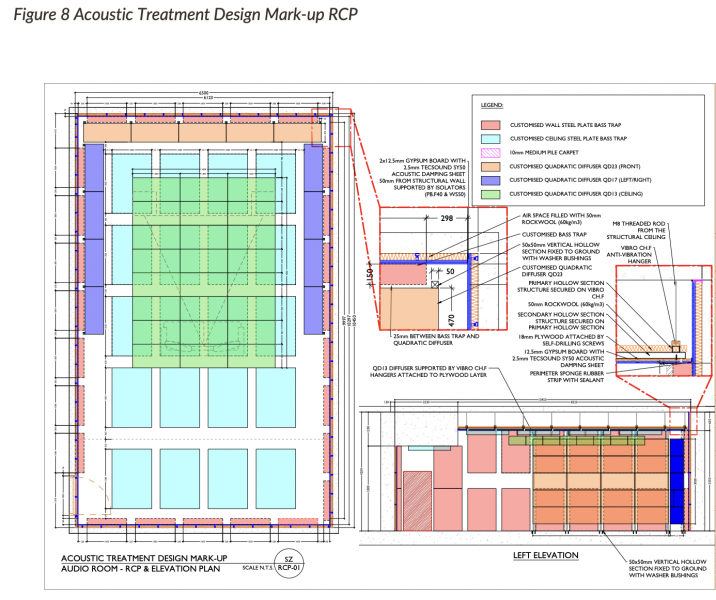
Please chime in with your experiences and suggestions for those prefixed with a "Q" !
Four walls:
1) first layer: dampened gypsum boards (air gap filled with dense Rockwool)
2) second layer: metal-plate Helmholtz bass resonators (tuned to the ~32Hz and ~43Hz axial room nodes)
3) third layer: P23 quadratic diffusors with the deepest bass diffusion bandwidth, for the front wall
4) shallower P17 quadratic diffusers for the sidewalls, but believe it's best not to have any closer than 2.0m from the listening position, due to undesirable comb filtering artifacts (which become inaudible at greater distances)
Q1) should the metal-plate Helmholtz bass resonators be mounted directly onto the structural walls, instead on the sheetrock?
Q2) should the sheetrock be mounted over the Helmholtz bass absorbers, and the larger air gap filled with dense Rockwool?
Q3) can the room be over-damped with too many Helmholtz bass absorbers, and if so, what might be the optimal % fill factor?
Q4) position/quantity of the sidewall P17 quadratic diffusers - one pair, two pairs, three pairs, or keep all four pairs?
Q5) quadratic 1D diffusers, BAD half-cylinders, or absorption (via dense open-cell foam) at the first reflection zones?
Q6) with so many metal-plate Helmholtz resonators, are corner bass traps needed or can they be disregarded to save space?
Ceiling:
1) first layer: metal plate Helmholtz bass resonators (tuned to the ~49Hz axial room node)
2) second layer: canopy, either P13 quadratic diffusers in a 2D configuration, or /lighter shallower 2D quadratic diffusers
Q1) ~3.5m high false ceilings imply 7.0m roundtrip; as acoustic energy returning from the ceiling are relatively weak and potentially inaudible, are ceiling diffusers a must-have?
Q2) deep, heavy, large P13 1D quadratic diffusers arranged into 2D configuration (90* orientation, alternating)?
Q3) alternatively, "2D diffusers" with 10x10 or 12x12 small squares?
Floor:
1) base finish: self-leveling epoxy + paint finish
Q1) option 1: vinyl tile flooring (covering the base finish)
Q2) option 2: polyester/nylon carpet "squares" (covering the base finish)
Q3) plywood over concrete, then engineered wood parquet
Carpet/rug:
Q1) option 1: thin rug (Persian-style?) placed on the rectangle between the loudspeakers and listening position
Q2) option 2: decorative rug made of open-weave fabric/yarn, to discourage over-absorption
Q3) option 3: low-pile carpet (IKEA type, typically available in 2m x 3m size), to encourage absorption of mids/highs

Last edited:
Hi Quad,Retearl, thank you for the suggestion for the Dunlavy. As I have mentioned, regret that I'm not a fan of MTM D'Appolito configurations, second-order crossover networks, nor discontinuous baffles which are a source of coherence-destructive diffraction.
Congratulations on your amazing room development.
I am curious what crossover network configurations do you like? Do you like smooth sloping baffles?
As stated in my posts #28, #38 and #43 - my loudspeaker preferences are NOT for 1st order [correction, of post #38's mention of 2nd order] crossover networks, and baffles with sharp corners/edges resembling Lego-bricks.Hi Quad,
Congratulations on your amazing room development.
I am curious what crossover network configurations do you like? Do you like smooth sloping baffles?
Last edited:
Pretty comprehensive system and well documented.Current proposal, with outstanding questions.
Please chime in with your experiences and suggestions for those prefixed with a "Q" !
Four walls:
1) first layer: dampened gypsum boards (air gap filled with dense Rockwool)
2) second layer: metal-plate Helmholtz bass resonators (tuned to the ~32Hz and ~43Hz axial room nodes)
3) third layer: P23 quadratic diffusors with the deepest bass diffusion bandwidth, for the front wall
4) shallower P17 quadratic diffusers for the sidewalls, but believe it's best not to have any closer than 2.0m from the listening position, due to undesirable comb filtering artifacts (which become inaudible at greater distances)
Q1) should the metal-plate Helmholtz bass resonators be mounted directly onto the structural walls, instead on the sheetrock?
Q2) should the sheetrock be mounted over the Helmholtz bass absorbers, and the larger air gap filled with dense Rockwool?
Q3) can the room be over damped with too many Helmholtz bass absorbers, and if so, what might be the optimal % fill factor?
Q4) position/quantity of the sidewall P17 quadratic diffusers - one pair, two pairs, three pairs, or keep all four pairs?
Q5) quadratic 1D diffusers, BAD half-cylinders, or absorption (via dense open-cell foam) at the first reflection zones?
Q6) with so many metal-plate Helmholtz resonators, are corner bass traps needed or can they be disregarded to save space?
Ceiling:
1) first layer: metal plate Helmholtz bass resonators (tuned to the ~49Hz axial room node)
2) second layer: canopy, either P13 quadratic diffusers in a 2D configuration, or /lighter shallower 2D quadratic diffusers
Q1) ~3.5m high false ceilings imply 7.0 roundtrip; as acoustic energy returning from the ceiling are relatively weak and potentially inaudible, are ceiling diffusers a must-have?
Q2) deep, heavy, large P13 1D quadratic diffusers arranged into a 2D configuration?
Q3) or will shallow and light 10x10 or 12x12 "square" 2D diffusors be sufficient?
Floor:
1) base finish: self-leveling epoxy + paint finish
Q1) option 1: vinyl tile flooring (covering the base finish)
Q2) option 2: polyester/nylon carpet "squares" (covering the base finish)
Q3) plywood over concrete, then engineered wood parquet
Carpet/rug:
Q1) option 1: thin rug ("Persian") placed on the rectangle between the loudspeakers and listening position
Q2) option 2: decorative rug made of open-weave fabric/yarn, to discourage over-absorption
Q3) option 3: low-pile carpet (IKEA type, typically available in 2m x 3m size), to encourage absorption of mids/highs
View attachment 112076
You and I probably dont agree on qrd so I will leave that out
WALLS
I think the sheetrock layer introduces a membrane absorber of unpredictable effect .. Is it for attenuating structure born sound .. if not I would delete it and hard plaster ( or stain ) concrete walls. You can then add and subtract the plate absorbers to get the desired result .. flexibility is important with bass and there is nothing worse than overdamping. Additionaly you may need some broadband absorbtion just to calm upper frequency that you can install on non critical locations as needed. You can have untreated concrete and all could be covered with a stetch fabric to visually calm the room when finalised ( I think @Bobvin did this)
BTW I would use bass absorbers in all 4 corners and all four wall/ceiling junctions for bass absorbtion .. its where energy is greatest
CEILINGS
I have a 3.4m ceiling and added ceiling baffles to stop reflections and it was a big improvement so I would say yes .. it calmed the room in a nice way
FLOOR
This is potentially the worst first refection .. there is an argument that are we used to this and our brain filters it easily but folks have reported improvements .. I would favour a persian rug over and underlay in the zone between speakers and chair and the rest reflective to keep that nice reverbarent tail while calming high fr reflections.
Anything else will not make much difference.
You can always add more rugs if too bright
You could always build a pit and grid floor over at reflection point
Regardless its bound to be a brilliant room.. looking forward to its progress
Cheers
Phil
Last edited:
As stated in my posts #28 and #38 - my loudspeaker preferences are NOT for 2nd order crossover networks, and baffles with sharp corners/edges resembling Lego-bricks.
Yes, but I am wondering what your preferences are for - just curious.
OK I re-read post 28, there is some more info there. I think you meant 1st order along with baffle alignment.
Last edited:
Dcathro, you're correct! Thanks for alerting me. Back in post #38, I meant 1st order (6dB/octave), and not 2nd order (12dB/octave). I've made a note of it in post #49. I prefer not to belabor this as it's simply my personal preference, but I believe that essentially, the trade-off is that 1st order designs limit/narrow the optimal listening position, as augmentations/cancellations (between drivers overlapping/reproducing a broader range of frequencies) are magnified. I've experienced this through Thiel 2 loudspeakers (see Stereophile review link below) which I owned for 3+ years in the 1980's, as well as more recently, brand "V" loudspeakers at trade shows. I prefer steeper-slope crossovers, despite the purported non-linearities in the time domain.Yes, but I am wondering what your preferences are for - just curious.
OK I re-read post 28, there is some more info there. I think you meant 1st order along with baffle alignment.
Thiel CS2 loudspeaker
The latest edition of Audio's annual equipment directory lists 238 speaker manufacturers. At best I can claim to have heard one product from 10–15% of the manufacturers on this list, and the top of the current product line from a far smaller percentage.
Last edited:
It's always good to know what you like and want! I wish you good luck on your journey! Will be looking out for the progress on your room.
My belief is that the room is by far the most important component!
My belief is that the room is by far the most important component!
Dcathro, you're correct! Thanks for alerting me. In post #38, I meant 1st order, and not 2nd order. I've made a note of it in post #49. I prefer not to belabor this as it's simply my personal preference, but I believe that essentially, the trade-off is that 1st order designs limit/narrow the optimal listening position, as augmentations/cancellations (between drivers overlapping/reproducing a broader range of frequencies) are magnified. I've experienced this through Thiel 2.2 speakers which I owned for 3+ years in the 1980's, as well as more recently, brand "V" loudspeakers at trade shows. I prefer steeper-slope crossovers, despite the purported non-linearities in the time domain.
Hi Quad, I didn't mean to put you on the defensive. No crossover topology is perfect, they all have their strengths and weaknesses and it depends on what you are sensitive to. I agree that 1st order crossovers are very difficult to implement and have some big limitations:
- inability to play loud;
- difficulty masking any driver resonances or frequency anomalies;
- much more difficult to get a flat response;
- need drivers that play way beyond their passband
- less than optimal polar response due to drivers being audible beyond their passband.
FRONT WALL (and front sidewall) ACOUSTIC TREATMENT: QRDs
The objectives of enhancing and preserving soundstage articulation and expression in two-channel stereo reproduction are fundamental goals for audiophiles. Decorrelating the spectral and temporal characteristics of the primary signal reflections is the key to reaching this objective. Essentially, the challenge is to create an ambient sound field which is highly uncorrelated to the primary signal, uniformly scrambled in directional, polar, spectral and temporal response, such that no direct "mirror image" hot spot reflections are discernible, delivering the aural illusion that the wall boundary has extended and retreated into the distance beyond its actual physical location.
Rather than aggressively absorbing precious mid/high frequency energy through foam, building insulation, thick carpets, upholstery, etc. on the front hemispherical wave-launch strike boundary strikes which undesirably "suck the life out" of the critical energy band necessary for ambient cues and soundstage envelopment, QRDs are engineered to create a decorrelated, incoherent cloud, while retaining most of the "lively" energy.
As my WBF moniker implies, I'm a huge fan of quadratic diffusers ("QRD"s). Through comb filtering, they redirect and scramble acoustic energy (laterally in 1D QRDs, and hemispherically in 2D QRDs) so the ear/brain combo can more readily distinguish and resolve the primary wave launch from the secondary and tertiary reflections. QRDs will selectively absorb certain frequencies pertaining to the quarter wavelength rule of the depth and volume of the zig-zagging wells, but by using a prime-number sequence (the larger the better!) of non-repeating, non-periodic sequences, the potential for hearing coherent "mirror image" direct in-phase reflections (the bane of binary-amplitude and cylindrical/spherical diffusers) is mitigated.
QRDs can be custom-built, sized with different well widths (defines upper frequency cutoff frequency), and most importantly, prime number periodicity and well depth (determines lower frequency cutoff frequency). Understanding which QRD (P13, P17, P23?) is most optimal for different locations within the listening room is important.
Theoretically, the lower the bandwidth (and the broader/more uniform the dispersion/scattering the better), but there are some real-world constraints and limitations such as viscous losses in cavity resonances (lumpy attenuation corresponding to the well resonant frequencies), expense/size, material flex, placement geometry/location affecting angle of incidences, and most importantly, adequately provisioning for the minimum listening distance (two times, but ideally, three times the wavelength of the lowest frequency diffused by the QRD).
The two first-reflection points on the two sidewalls deserves special attention, as they have the potential to completely destroy the carefully crafted soundstage, by being:
- too loud (not attenuated enough)
- too correlated (not scrambled enough)
Together with perfect L/R symmetry, I’d like the sidewall reflections to meet four of the following psychoacoustical criteria:
1) placed outside of the minimum prescribed distance (as per the 2x-3x lowest frequency wavelength rule)
2) Haas effect: that the sidewall signals arrive inside of 12-20ms relative to the primary signal
3) precedence effect: ensure that the sidewall signals are attenuated by at least 6dB (in the presence region) relative to the primary signal
4) that the reflected energy is delivered from a direction (relative to the midline to the center of the front wall) 60* to the L, and 60* from the R, in a 120* spread (see my post #30 on the thread below). The L and R speakers will be placed 30* to the L, and 30* to the R, in a 60* spread, assuming an equilateral triangle placement.
 www.whatsbestforum.com
www.whatsbestforum.com
I suspect that raytracing simulations will recommend not having any P23 QRDs in close proximity to the listening position. Perhaps I will have P23 QRDs on the sidewalls corners (with its width occupying 1.26m of sidewall space), followed by P17s (its width occupying an additional 0.905m of sidewall space), in a one-step gradient? Together, the two different QRDs will cover 2.165m of horizontal/linear sidewall space on both sidewalls, creating a "C" shape of wall modules (when viewed from above). As I plan to distance my speakers ~2.5m from the front wall slab, the sidewall QRDs will not protrude into the space directly to the L and R space of the speakers.
AFMG Reflex is the software which most appropriately models and quantifies the characteristics of various QRDs which I'll be using for my future dedicated basement listening room.
www.mediterraneanacoustics.com/afmg-reflex---for-the-design-and-application-of-diffusers.html
"AFMG Reflex is a two-dimensional acoustics simulation software to model the reflection, diffusion, and scattering of a sound wave incident upon a defined geometrical structure.
Within AFMG Reflex the shape of the reflective surface is entered as a two-dimensional cross-section as would be seen from overhead looking down at the shape. Reflex assumes that this cross-sectional geometry extends infinitely in the third dimension, i.e. into and out of the computer monitor screen. The surface defined by this geometry is also assumed to be perfectly rigid. This means the surface is 100% reflective and does not in any way absorb sound or allow sound to be transmitted through it.
These assumptions are required for the mathematical approach that Reflex is using. It is based on the Boundary Element Method (BEM) to calculate the reflection, diffusion, and scattering properties of the surface. The reflective properties are displayed as a polar response graph for any angle of incidence and frequency of a sound wave. The scattering and diffusion coefficients are displayed as frequency response graphs.
The calculation of the scattering coefficients is based on the work of Mommertz, Vorländer, and ISO 17497-1. The calculation of the diffusion coefficients is according to Cox and D’Antonio and to the ISO 17497-2 standard which is currently in preparation."
The objectives of enhancing and preserving soundstage articulation and expression in two-channel stereo reproduction are fundamental goals for audiophiles. Decorrelating the spectral and temporal characteristics of the primary signal reflections is the key to reaching this objective. Essentially, the challenge is to create an ambient sound field which is highly uncorrelated to the primary signal, uniformly scrambled in directional, polar, spectral and temporal response, such that no direct "mirror image" hot spot reflections are discernible, delivering the aural illusion that the wall boundary has extended and retreated into the distance beyond its actual physical location.
Rather than aggressively absorbing precious mid/high frequency energy through foam, building insulation, thick carpets, upholstery, etc. on the front hemispherical wave-launch strike boundary strikes which undesirably "suck the life out" of the critical energy band necessary for ambient cues and soundstage envelopment, QRDs are engineered to create a decorrelated, incoherent cloud, while retaining most of the "lively" energy.
As my WBF moniker implies, I'm a huge fan of quadratic diffusers ("QRD"s). Through comb filtering, they redirect and scramble acoustic energy (laterally in 1D QRDs, and hemispherically in 2D QRDs) so the ear/brain combo can more readily distinguish and resolve the primary wave launch from the secondary and tertiary reflections. QRDs will selectively absorb certain frequencies pertaining to the quarter wavelength rule of the depth and volume of the zig-zagging wells, but by using a prime-number sequence (the larger the better!) of non-repeating, non-periodic sequences, the potential for hearing coherent "mirror image" direct in-phase reflections (the bane of binary-amplitude and cylindrical/spherical diffusers) is mitigated.
QRDs can be custom-built, sized with different well widths (defines upper frequency cutoff frequency), and most importantly, prime number periodicity and well depth (determines lower frequency cutoff frequency). Understanding which QRD (P13, P17, P23?) is most optimal for different locations within the listening room is important.
Theoretically, the lower the bandwidth (and the broader/more uniform the dispersion/scattering the better), but there are some real-world constraints and limitations such as viscous losses in cavity resonances (lumpy attenuation corresponding to the well resonant frequencies), expense/size, material flex, placement geometry/location affecting angle of incidences, and most importantly, adequately provisioning for the minimum listening distance (two times, but ideally, three times the wavelength of the lowest frequency diffused by the QRD).
The two first-reflection points on the two sidewalls deserves special attention, as they have the potential to completely destroy the carefully crafted soundstage, by being:
- too loud (not attenuated enough)
- too correlated (not scrambled enough)
Together with perfect L/R symmetry, I’d like the sidewall reflections to meet four of the following psychoacoustical criteria:
1) placed outside of the minimum prescribed distance (as per the 2x-3x lowest frequency wavelength rule)
2) Haas effect: that the sidewall signals arrive inside of 12-20ms relative to the primary signal
3) precedence effect: ensure that the sidewall signals are attenuated by at least 6dB (in the presence region) relative to the primary signal
4) that the reflected energy is delivered from a direction (relative to the midline to the center of the front wall) 60* to the L, and 60* from the R, in a 120* spread (see my post #30 on the thread below). The L and R speakers will be placed 30* to the L, and 30* to the R, in a 60* spread, assuming an equilateral triangle placement.
My dedicated audio room build - QuadDiffusor's Big Dig
There is of course another room acoustical technology that provides a third approach to dealing with low frequencies. Developed for and in use by well known film/recording/mixing studios (links to examples below), it is based on very high numbers per sf of non-parallel surfaces (DHDI ZR...
I suspect that raytracing simulations will recommend not having any P23 QRDs in close proximity to the listening position. Perhaps I will have P23 QRDs on the sidewalls corners (with its width occupying 1.26m of sidewall space), followed by P17s (its width occupying an additional 0.905m of sidewall space), in a one-step gradient? Together, the two different QRDs will cover 2.165m of horizontal/linear sidewall space on both sidewalls, creating a "C" shape of wall modules (when viewed from above). As I plan to distance my speakers ~2.5m from the front wall slab, the sidewall QRDs will not protrude into the space directly to the L and R space of the speakers.
AFMG Reflex is the software which most appropriately models and quantifies the characteristics of various QRDs which I'll be using for my future dedicated basement listening room.
www.mediterraneanacoustics.com/afmg-reflex---for-the-design-and-application-of-diffusers.html
"AFMG Reflex is a two-dimensional acoustics simulation software to model the reflection, diffusion, and scattering of a sound wave incident upon a defined geometrical structure.
Within AFMG Reflex the shape of the reflective surface is entered as a two-dimensional cross-section as would be seen from overhead looking down at the shape. Reflex assumes that this cross-sectional geometry extends infinitely in the third dimension, i.e. into and out of the computer monitor screen. The surface defined by this geometry is also assumed to be perfectly rigid. This means the surface is 100% reflective and does not in any way absorb sound or allow sound to be transmitted through it.
These assumptions are required for the mathematical approach that Reflex is using. It is based on the Boundary Element Method (BEM) to calculate the reflection, diffusion, and scattering properties of the surface. The reflective properties are displayed as a polar response graph for any angle of incidence and frequency of a sound wave. The scattering and diffusion coefficients are displayed as frequency response graphs.
The calculation of the scattering coefficients is based on the work of Mommertz, Vorländer, and ISO 17497-1. The calculation of the diffusion coefficients is according to Cox and D’Antonio and to the ISO 17497-2 standard which is currently in preparation."
Last edited:
Very interesting.. have you tried it out.As my WBF moniker implies, I'm a huge fan of quadratic diffusers. They can be constructed with different materials, sized with different well widths (upper frequency bandwidth breadth), and most importantly, prime number periodicity and well depth, which determines lower frequency diffusion bandwidth breadth.
AFMG Reflex is the software which most appropriately models and quantifies the characteristics of various quadratic diffusers which I'm considering for my future dedicated basement listening room.
www.mediterraneanacoustics.com/afmg-reflex---for-the-design-and-application-of-diffusers.html
"AFMG Reflex is a two-dimensional acoustics simulation software to model the reflection, diffusion, and scattering of a sound wave incident upon a defined geometrical structure.
Within AFMG Reflex the shape of the reflective surface is entered as a two-dimensional cross-section as would be seen from overhead looking down at the shape. Reflex assumes that this cross-sectional geometry extends infinitely in the third dimension, i.e. into and out of the computer monitor screen. The surface defined by this geometry is also assumed to be perfectly rigid. This means the surface is 100% reflective and does not in any way absorb sound or allow sound to be transmitted through it.
These assumptions are required for the mathematical approach that Reflex is using. It is based on the Boundary Element Method (BEM) to calculate the reflection, diffusion, and scattering properties of the surface. The reflective properties are displayed as a polar response graph for any angle of incidence and frequency of a sound wave. The scattering and diffusion coefficients are displayed as frequency response graphs.
The calculation of the scattering coefficients is based on the work of Mommertz, Vorländer, and ISO 17497-1. The calculation of the diffusion coefficients is according to Cox and D’Antonio and to the ISO 17497-2 standard which is currently in preparation."
Nice if pretty easy to get your head around ... quite expensive but may well be worth it.
At a simpler level I see the amroc guys are developing a more " pro version " for sale .. will also be interesting to see how deep it dives
Do you see yourself doing different diffusers as the location changes
Phil
Sharing below simulation results for P13, P17, and P23 QRDs, provided by my acoustic consultant which I hired. The AFMG Reflex program has tremendous flexibility and accepts multiple parameters to model a variety of geometric diffusion modules, but for this example I'm keeping things simple.
Inputs:
- primary signal directed from a 45 degree angle (as opposed to 0 degrees, or head-on) which better simulates reality
Outputs:
- spatial response curves of 500Hz, 1kHz, and 2kHz (overlaid on a hemispheric polar graph)
- broader 100Hz to 4kHz range for the calculation of scattering, normalized diffusion, and diffusion coefficients
Inputs:
- primary signal directed from a 45 degree angle (as opposed to 0 degrees, or head-on) which better simulates reality
Outputs:
- spatial response curves of 500Hz, 1kHz, and 2kHz (overlaid on a hemispheric polar graph)
- broader 100Hz to 4kHz range for the calculation of scattering, normalized diffusion, and diffusion coefficients
Last edited:
Similar threads
- Replies
- 9
- Views
- 971
- Replies
- 26
- Views
- 3K
- Replies
- 6
- Views
- 2K
- Replies
- 14
- Views
- 2K


